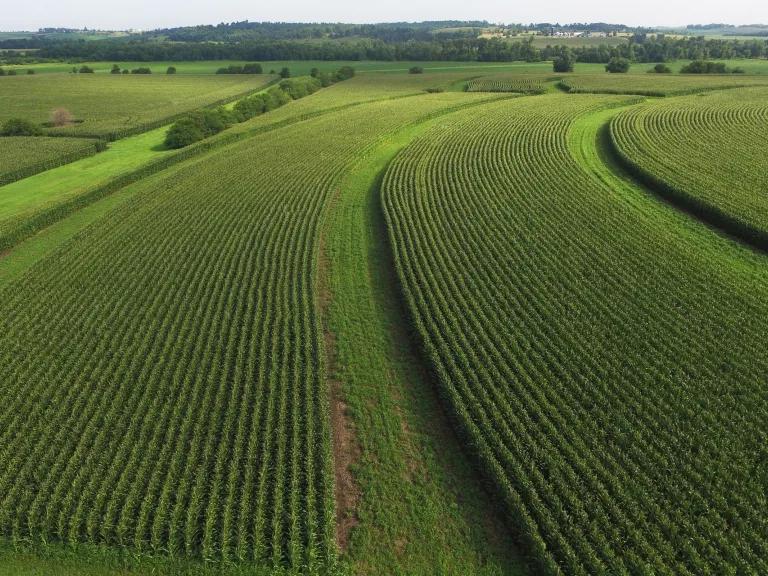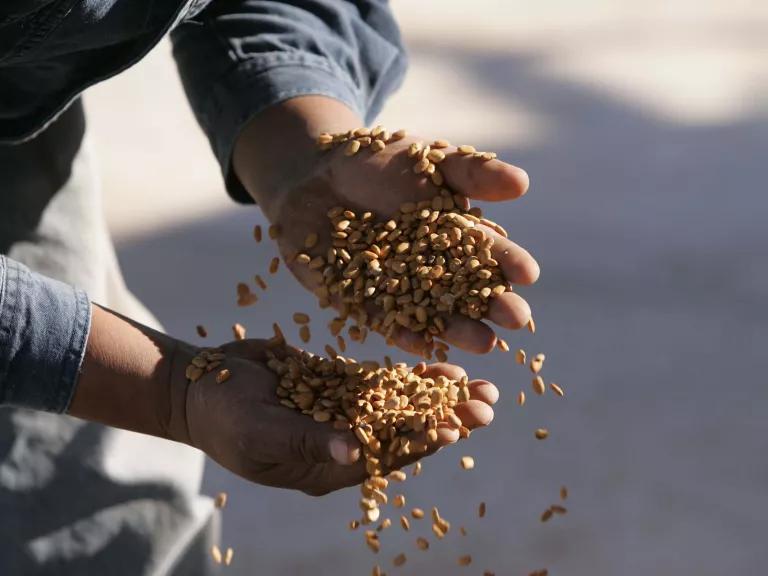“When we speak with farmers and ranchers focused on regenerative agriculture, they tell us that their notion of ‘success’ goes beyond yield and farm size,” says Lara Bryant, deputy director of water and agriculture at NRDC. “Regenerative agriculture is a holistic and sustainable approach to farming and land management that focuses on restoring and improving the health of ecosystems and the soil. It goes beyond traditional sustainable agriculture practices by emphasizing the restoration of soil health, biodiversity, and ecological balance. The goal of regenerative agriculture is to create resilient and productive agricultural systems that can adapt to changing environmental conditions while also providing a variety of benefits, including improved food quality, increased farm profitability, and reduced environmental impact.
Regenerative Agriculture Is a Philosophy
At its core, regenerative agriculture is farming and ranching in harmony with nature. Practitioners take a broader view of their role in the world, especially in terms of soil and nutrient cycles. “We need to realize that working landscapes provide not just products but also ecosystem services like carbon sinks, water recharge, and evolutionary potential,” says Leonard Diggs of Pie Ranch, an incubator farm where he teaches regenerative agriculture. “We need agriculture that does not lose our carbon and does not deplete our people.”
By contrast, the industrial agricultural system that dominates Western food and fiber supply chains incentivizes practices that promote soil erosion at a rate of 10 to 100 times higher than soil formation; nutrient runoff and harmful algal blooms in freshwater and coastal systems; and monocropping and other threats to local biodiversity, including critical pollinators. These systems compartmentalize natural resources and focus on the yields of individual crops.
Key principles and practices of regenerative agriculture include:
Soil Health: Regenerative agriculture places a strong emphasis on building and maintaining healthy soils. This involves practices such as minimal soil disturbance (reduced tillage), cover cropping, crop rotation, and the use of organic matter (compost and cover crops) to improve soil structure and fertility.
Biodiversity: Encouraging biodiversity in and around agricultural systems is essential for pest control, pollination, and overall ecosystem health. This can involve planting hedgerows, maintaining native vegetation, and creating habitat for beneficial insects and wildlife.
Crop Rotation and Diversity: Rotating crops and diversifying plant species help break pest and disease cycles, reduce the need for chemical inputs, and improve soil health.
Regenerative Agriculture Principles
It includes things like joy and happiness, the number of families they feed, watching how the land regenerates and flourishes, the money saved from not purchasing chemical inputs, the debt avoided by repurposing old equipment, and the relationships built with community members.” Below are some of the principles they utilize to achieve these goals.
No or Reduced Synthetic Inputs: Regenerative agriculture seeks to minimize the use of synthetic fertilizers, pesticides, and herbicides. Instead, it promotes natural alternatives and integrated pest management.
Conservation Tillage: Reducing or eliminating tillage practices helps prevent soil erosion, carbon loss, and disruption of soil ecosystems.
Water Management: Implementing water-conservation practices, such as precision irrigation and rainwater harvesting, is important for maintaining water quality and reducing water consumption.
Livestock Integration: Integrating livestock into farming systems, such as rotational grazing, can enhance nutrient cycling, reduce the need for synthetic fertilizers, and improve soil health.
Holistic Management: Regenerative agriculture often involves holistic land management approaches that consider the interconnectedness of all elements within an ecosystem. This includes careful planning and monitoring to optimize resource use and maintain ecosystem balance.
Prioritize Soil Health
While the techniques for caring for the soil vary with the context of each farm, generally, regenerative growers limit mechanical soil disturbance. Instead, they feed and preserve the biological structures that bacteria, fungi, and other soil microbes build underground—which provide above-ground benefits in return.

Reduce Reliance on Synthetic Inputs
Regenerative farmers and ranchers make every effort to reduce their reliance on synthetic inputs, such as herbicides, pesticides, and chemical fertilizers. In the process of prioritizing soil health, many growers naturally use fewer chemical inputs. Instead, as beneficial insects and wildlife return and diverse crop and livestock rotations disrupt weed cycles, the ecosystem becomes more resilient. And with fewer toxic chemicals, there are reduced human health risks as well as increased financial independence from avoiding the recurring costs of synthetic inputs.
Carbon Sequestration: By enhancing soil health and plant cover, regenerative agriculture can increase carbon sequestration in the soil, helping to mitigate climate change.
Economic Viability: Farmers adopting regenerative practices often aim to increase their economic resilience by reducing input costs, improving soil fertility, and diversifying income streams through value-added products.
Regenerative agriculture is gaining popularity worldwide as a response to the environmental challenges associated with conventional agriculture, such as soil degradation, loss of biodiversity, and climate change. Many farmers, researchers, and organizations are actively promoting and implementing regenerative agricultural practices to create more sustainable and resilient food systems.


